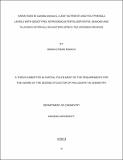| dc.contributor.author | Kwach, Bowa Otieno | |
| dc.date.accessioned | 2018-05-02T08:46:19Z | |
| dc.date.available | 2018-05-02T08:46:19Z | |
| dc.date.issued | 2013 | |
| dc.identifier.citation | Kwach, B.O. (2013). Variations in Camellia sinensis (L) Leaf Nutrients and Polyphenols Levels with Genotypes, Nitrogenous Fertilizer Rates, Season and Plucking Intervals in Eastern Africa Tea Growing Regions, PhD Thesis, Maseno University | en_US |
| dc.identifier.uri | https://repository.maseno.ac.ke/handle/123456789/491 | |
| dc.description | A Thesis Submitted in Partial Fulfilment of the Requirements for the Award of the Degree of Doctor of Philosophy in Chemistry, Department of Chemistry, Maseno University | en_US |
| dc.description.abstract | In Eastern Africa, teas are grown in high rainfall areas causing fast nutrients depletion. Foliar nutrients diagnostic limits developed for seedling tea have been in use since 1970s and they have been adopted for clonal tea in Eastern Africa without validation. It is not known if the limits are suitable for clonal teas. Tea farmers usually import high quality clones across different regions; however their quality has not been replicated in new regions. Factors causing the quality variations and how the quality precursor compounds vary with agronomic inputs, season and locations are unknown. Nitrogen fertilizer rates and harvesting intervals influence tea yields and quality. However, it is not known how nitrogen rates influence the leaf nutrients and black tea quality precursors in Eastern Africa. This study assessed suitability of seedling tea diagnostic limits on clonal tea in different locations, the effect of genotypes, seasons and location of production on leaf caffeine and flavan-3-ols in Kenya and the influence of nitrogenous fertilizer rates and plucking interval on mature leaf nutrients and nitrogen rates on flavan-3-ols in different locations in Eastern Africa. The research was superimposed on two ongoing trials: a clonal trial involving twenty clones in Kenya and a fertilizer trial on clone TRFK 6/8 in Eastern Africa. Leaf nutrients, flavan-3-ols and caffeine levels were determined. The data was analyzed using appropriate factorial design for each trial. Leaf nutrients varied (P ≤ 0.05) with clones and locations with interactions (P ≤ 0.05) between clones and locations. The level of nutrients in clonal leaf did not concur with set limits in seedling tea. Increasing nitrogen rates decreased P, K, Ca and Mg levels but increased levels of N, Mn, Zn, and Fe in mature leaf. Plucking frequency did not affect leaf nutrients. Caffeine and flavan-3-ols varied (P ≤ 0.05) with location, genotype and fertilizer rate but not with season. Flavan-3-ols and their ratios all varied (P ≤ 0.05) with clones and nitrogen rates but not with site and season. These results demonstrate that diagnostic nutrients limits set for seedling tea may not be suitable for clonal tea. Variations in caffeine and the flavan-3-ols explain the previously observed plain black tea quality changes with clones, locations and nitrogen rates. It is recommended that region and clonal specific foliar diagnostic guidelines be developed, clones be tested and recommended for areas of their optimal quality potential and region specific nitrogen fertilizer rates for clones be developed in the growing regions. | en_US |
| dc.description.sponsorship | The Inter University Council for Eastern Africa, through Lake Victoria Research Initiative (VicRes) and the National Council for Science and Technology, Kenya | en_US |
| dc.language.iso | en | en_US |
| dc.publisher | Mase University | en_US |
| dc.subject | Leaf nutrients, polyphenols, clonal tea, genotypes, nitrogen fertilizers, seasons, plucking intervals geographcal area of production, East Africa | en_US |
| dc.title | Variations in Camellia sinensis (L) Leaf Nutrients and Polyphenols Levels with Genotypes, Nitrogenous Fertilizer Rates, Season and Plucking Intervals in Eastern Africa Tea Growing Regions | en_US |
| dc.type | Thesis | en_US |

